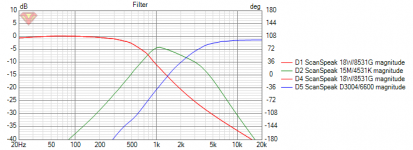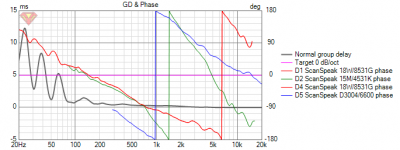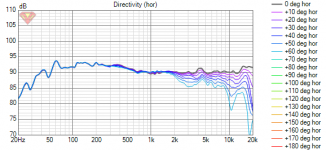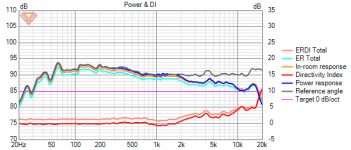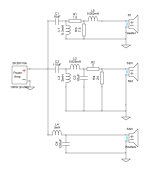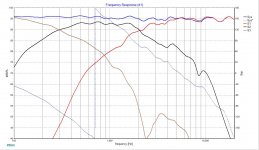A few years back I bought a set of drivers and the time has come to make something out of them. I have started to model the crossovers and wanted to hear if you think I might be on the right track.
Elements:
Enclosure-wise, I am thinking that a 60 liter bass reflex box for the woofers and a closed enclosure for the midrange, something similar to Troels Gravesens Ekta Grande might be reasonable as a first trial box.
This is just an early sketch, so it is based on traced SPL and impedance curves from Scan Speak. Break-in and TS-measurements are under way. The crossover is modelled without a box and assuming all drivers are mounted with aligned acoustic centers.
I have attempted to integrate a baffle step around 500Hz and I have tried to keep the impedance above 3 Ohms.
What are your thoughts on this - on the right track here?
Another question, do you think it will be possible to drive mid+tweeter with a tube amp with this kind of impedance?
Elements:
Enclosure-wise, I am thinking that a 60 liter bass reflex box for the woofers and a closed enclosure for the midrange, something similar to Troels Gravesens Ekta Grande might be reasonable as a first trial box.
This is just an early sketch, so it is based on traced SPL and impedance curves from Scan Speak. Break-in and TS-measurements are under way. The crossover is modelled without a box and assuming all drivers are mounted with aligned acoustic centers.
I have attempted to integrate a baffle step around 500Hz and I have tried to keep the impedance above 3 Ohms.
What are your thoughts on this - on the right track here?
Another question, do you think it will be possible to drive mid+tweeter with a tube amp with this kind of impedance?
Attachments
My thoughts? Spend some money on a measurement mike and get real data from the drivers in your enclosure. Point.
What are you crossover points? From your simulation it looks the band-pass for the mid range is too small. If you put the low pass and high pass to close they will interfere with each other. Rule of thumb is the high pass should be 8 times to 10 times higher than the low pass. The classic 300hzHZ to 3Khz is a good starting point. If you are going active you might be able to ignore this, not sure. Not only does the filter work better, but it pushed the XO out of the telephone band.A few years back I bought a set of drivers and the time has come to make something out of them. I have started to model the crossovers and wanted to hear if you think I might be on the right track.
Elements:
Enclosure-wise, I am thinking that a 60 liter bass reflex box for the woofers and a closed enclosure for the midrange, something similar to Troels Gravesens Ekta Grande might be reasonable as a first trial box.
This is just an early sketch, so it is based on traced SPL and impedance curves from Scan Speak. Break-in and TS-measurements are under way. The crossover is modelled without a box and assuming all drivers are mounted with aligned acoustic centers.
I have attempted to integrate a baffle step around 500Hz and I have tried to keep the impedance above 3 Ohms.
What are your thoughts on this - on the right track here?
Another question, do you think it will be possible to drive mid+tweeter with a tube amp with this kind of impedance?
500/2500 would be my recommendation for xover points. Make sure you damp the 800/900 Hz resonance on the mid.
Well, of course. Like I said, this is just an early sketch. I wanted to see if you guys have any input on the general idea before I start building. I will get back with updates on this.My thoughts? Spend some money on a measurement mike and get real data from the drivers in your enclosure. Point.
Good input, the current design filters at around 850. I will lower this to something at or below 500 Hz.500/2500 would be my recommendation for xover points. Make sure you damp the 800/900 Hz resonance on the mid.
Regarding the resonance around 800-900, I was thinking maybe I would wait to see how they meausure before I implement a notch. I was kind of hoping to adress it along in the high-pass section.
Last edited:
It could work out that way that they could work together. I wouldn't got below 400Hz though, as you really don't need to.
Interesting thread, I will be following as this is very similar to my upcoming build:
Scanspeak R3004/6020-10
Scanspeak 15M4531
2x Scanspeak 15W8531
Mine will be MTWW. Sealed, active, and compact. Only 60cm high with no stand (hence midrange above tweeter). I was thinking of crossover points of 250, and 2500, though Wolf's comments may change my mind. Anyway it will be minidsp active, so very flexible in terms of tuning.
Scanspeak R3004/6020-10
Scanspeak 15M4531
2x Scanspeak 15W8531
Mine will be MTWW. Sealed, active, and compact. Only 60cm high with no stand (hence midrange above tweeter). I was thinking of crossover points of 250, and 2500, though Wolf's comments may change my mind. Anyway it will be minidsp active, so very flexible in terms of tuning.
Here's my reasoning...
When Pete built his Byzantiums (A squat, half-boat-shaped 3-way with the RSS315HF-8, the 15W4531 and venerable (NLA) RS28A), he found that even though the wider baffle would typically lend well to a lower xover due to the baffle-step, that it just sounded wrong. He found the best 'weight' to the mids was HP at 500Hz. Higher thinned them out, and lower had no benefit, especially with regards to xmax usage on the midrange. All that have heard the 15W variants know that they do mids very well, and getting the vocal range majority will benefit here. The 7" I don't feel does them as well. However, both are wider bandwidth drivers and can help each other. It is also easier to get good blending in xovers with the mid xoverd in this range, no matter the drivers used in such a design.
Just my opinion, but I think dual 15W8531 per side would leave me wanting more for woofers. (If you're doing a sub to augment it, then why go 3-way.)
The R tweeter will like 2.5kHz as well, as ring-tweeters tend to have rising HD as they play lower. You may have to comp the Fs with shallow slopes or it might buzz a bit. I would also advise to NOT use 8th order slopes with these drivers. They are still relatively SOTA, and have broad bandwidth. Blending with shallower slopes will likely sound very very good.
When Pete built his Byzantiums (A squat, half-boat-shaped 3-way with the RSS315HF-8, the 15W4531 and venerable (NLA) RS28A), he found that even though the wider baffle would typically lend well to a lower xover due to the baffle-step, that it just sounded wrong. He found the best 'weight' to the mids was HP at 500Hz. Higher thinned them out, and lower had no benefit, especially with regards to xmax usage on the midrange. All that have heard the 15W variants know that they do mids very well, and getting the vocal range majority will benefit here. The 7" I don't feel does them as well. However, both are wider bandwidth drivers and can help each other. It is also easier to get good blending in xovers with the mid xoverd in this range, no matter the drivers used in such a design.
Just my opinion, but I think dual 15W8531 per side would leave me wanting more for woofers. (If you're doing a sub to augment it, then why go 3-way.)
The R tweeter will like 2.5kHz as well, as ring-tweeters tend to have rising HD as they play lower. You may have to comp the Fs with shallow slopes or it might buzz a bit. I would also advise to NOT use 8th order slopes with these drivers. They are still relatively SOTA, and have broad bandwidth. Blending with shallower slopes will likely sound very very good.
Hi Wolf
Thanks for the thorough explanation.
I remember the Byzantiums. Great build. Inspirational.
I am aiming for a very compact three-way. I have used the 15W4531 before in a two-way, so I have an idea what to expect. As you will surely know, there are many many documented two-way builds with the 5.5" Scanspeak Revelators. Most report an astonishingly full-range result (given their size). My thinking is that using two of the drivers for bass duty (sealed), and having the ability to boost them with minidsp EQ would give me a good improvement on the two way designs (Zaph's ZD5, Troel's Ellam, Carmody's Carrera, etc). If I went with a sub, I would have to cross below 150Hz or have the driver on the baffle, which I cannot accommodate for size restrictions.
I hope that I am not crashing this thread. The 15M4531 will be the make or break of the OP's build (and mine), I think. It is a surprising seldom used driver (in documented builds).
Thanks for the thorough explanation.
I remember the Byzantiums. Great build. Inspirational.
I am aiming for a very compact three-way. I have used the 15W4531 before in a two-way, so I have an idea what to expect. As you will surely know, there are many many documented two-way builds with the 5.5" Scanspeak Revelators. Most report an astonishingly full-range result (given their size). My thinking is that using two of the drivers for bass duty (sealed), and having the ability to boost them with minidsp EQ would give me a good improvement on the two way designs (Zaph's ZD5, Troel's Ellam, Carmody's Carrera, etc). If I went with a sub, I would have to cross below 150Hz or have the driver on the baffle, which I cannot accommodate for size restrictions.
I hope that I am not crashing this thread. The 15M4531 will be the make or break of the OP's build (and mine), I think. It is a surprising seldom used driver (in documented builds).
Musings:
Skip the mid, or put it at the back to maintain vibrational symmetry for the woofers, and arrange the woofers a la d'Appolito.
You could probably bring the impedance way up by running the woofers @ 16 ohm, and change the tweeter pad. Your tube amp will thank you for the lower current. And tune the bass alignment so the resonance provides useful EQ rather than unwanted bloat.
Skip the mid, or put it at the back to maintain vibrational symmetry for the woofers, and arrange the woofers a la d'Appolito.
You could probably bring the impedance way up by running the woofers @ 16 ohm, and change the tweeter pad. Your tube amp will thank you for the lower current. And tune the bass alignment so the resonance provides useful EQ rather than unwanted bloat.
(Wolf's Scandivifias....) <------ Yeah, you forgot that one in your list.Hi Wolf
Thanks for the thorough explanation.
I remember the Byzantiums. Great build. Inspirational.
I am aiming for a very compact three-way. I have used the 15W4531 before in a two-way, so I have an idea what to expect. As you will surely know, there are many many documented two-way builds with the 5.5" Scanspeak Revelators. Most report an astonishingly full-range result (given their size). My thinking is that using two of the drivers for bass duty (sealed), and having the ability to boost them with minidsp EQ would give me a good improvement on the two way designs (Zaph's ZD5, Troel's Ellam, Carmody's Carrera, etc). If I went with a sub, I would have to cross below 150Hz or have the driver on the baffle, which I cannot accommodate for size restrictions.
I hope that I am not crashing this thread. The 15M4531 will be the make or break of the OP's build (and mine), I think. It is a surprising seldom used driver (in documented builds).
The 15M is not that old of a driver, so it's understandable why it's not more prevalent.
I don't understand why you wouldn't use the 8530K00 and vent them for best extension without needing the boost at all. The group delay will be the same with a vented box as the boosted-sealed box if the drivers and transfer functions are the same. To top it off, the vented box will be likely more efficient, and protect the drivers better around resonance/Fb. If you already have them, then my query has no significance.
Hi Wolf
The 8530K00 is clearly an even better candidate for bass duty, but I wanted to avoid the coated finish for aesthetic reasons. Each cab will have three identical looking drivers. Yes, I already have the 15W8531 drivers.
The 8530K00 is clearly an even better candidate for bass duty, but I wanted to avoid the coated finish for aesthetic reasons. Each cab will have three identical looking drivers. Yes, I already have the 15W8531 drivers.
I would give 15M as much bandwidth as possible. 300/3000 LR2 xo acoustic, with help of natural roll-off of each driver would be a good starting point. Xo around 500-600Hz is too much in middle of female voice or many instruments' scale. I have never heard any TG speakers, but I agree with mtidge, I have "always" wondered why 15M's potential is wasted by using it as a filler. It should have the lead role!
With multich-dsp like minidsp 2x4HD and recycle-bin-rescued amps it is very easy to test different xo solutions, by listening to a single speaker. Simulations with VituixCAD or alike are just for curiosity, unless one is familiar with drivers. I have ended in LR2 instead of LR4 in all of my 3/4-way projects, speakers just sound better that way, despite measurements look better with LR4.
With multich-dsp like minidsp 2x4HD and recycle-bin-rescued amps it is very easy to test different xo solutions, by listening to a single speaker. Simulations with VituixCAD or alike are just for curiosity, unless one is familiar with drivers. I have ended in LR2 instead of LR4 in all of my 3/4-way projects, speakers just sound better that way, despite measurements look better with LR4.
So, now I have built the test cabs, made measurements and designed a crossover in XSim. It will be interesting to see if you have any input.
Elements:
Test cabs:
Measurements:
Crossover:
So, the plan is to hook the speakers up to my digital filter and listen to the voicing with the crossover points, but before I dive into that, I wanted to hear if you have any input on the build of the test cabs, the measurement technique and the crossover design. I probably made mistakes along the way, and learning about them before I order crossover parts would be great! 😎
Attached is the measurements, pictures from XSim and the XSim ".dxo" file if anyone wants to load the project into XSim and take a closer look.
As can be seen from the SPL curve where the mid is not inverted, the phase integration with the woofers seems OK, but the suck-out expected at the crossover point with the tweeter is not as ddep as I would have hoped. I guess that comes down to the flat baffle. Is it worth trying to handle this in the crossover do you think? Should I modify the baffle with a step or slant? Or should I not bother at all?
Let me know what you think!
Elements:
- Scanspeak 18W/8531G (dual, wired in parallel)
- Scanspeak 15M/4531K
- ScanSpeak d3004/6600
- Mids and woofers broken in, playng a sine wave at their respective resonance frequency for about 10 hours.
Test cabs:
- 22mm MDF, except baffle which is 2x22mm MDF.
- Separate sections for the mid and the tweeter.
- Mid enclosure is sealed, 3.3l, glued meticulously to be air-tight.
- 45 degree chamfer of mid and bass cutouts
- All surfaces covered in 7mm felt and top/bottom has been damped with polyester to reduce vertical standing waves.
- Bass enclosure behind port filled coated with thick layer of sheep wool (after the pictures were taken)
Measurements:
- Obtained using a calibrated UMIK-1
- Dual woofers measures as one unit, both impedance and farfield
- Only farfield (1m), since merging with nearfield seems to ruin phase
- Mic placed vertically at a level between tweeter and mid
- Measurements performed indoor with cabs raised from the floor
- Impulse response windows for each driver between 3.3 and 4.4ms since distance to nearest surface is different for the drivers
- Measurements accurate down to about 300Hz
- All drivers measured individually and in parallel. Parallel measurement used only to allow adjustment of delay.
- Mid delayed 0.47in
- Woovers delayd 1.56in
- Impedance measured using custom jig, with drivers mounted in the enclosures
- Response tails identified in XSim using farfield merged with nearfield
Crossover:
- Second order filters for all sections
- Additional inductance (L5) added to tame tweeters rising response above 10kHz
- Parallel notch filter added to mid to tame bump around 1.5kHz
- Crossover points 290Hz and 2800Hz
So, the plan is to hook the speakers up to my digital filter and listen to the voicing with the crossover points, but before I dive into that, I wanted to hear if you have any input on the build of the test cabs, the measurement technique and the crossover design. I probably made mistakes along the way, and learning about them before I order crossover parts would be great! 😎
Attached is the measurements, pictures from XSim and the XSim ".dxo" file if anyone wants to load the project into XSim and take a closer look.
As can be seen from the SPL curve where the mid is not inverted, the phase integration with the woofers seems OK, but the suck-out expected at the crossover point with the tweeter is not as ddep as I would have hoped. I guess that comes down to the flat baffle. Is it worth trying to handle this in the crossover do you think? Should I modify the baffle with a step or slant? Or should I not bother at all?
Let me know what you think!
Attachments
-
Attempt5.dxo9.5 MB · Views: 62
-
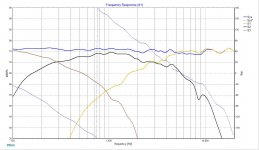 SPL.jpg128.2 KB · Views: 189
SPL.jpg128.2 KB · Views: 189 -
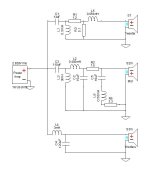 XO.jpg28.3 KB · Views: 187
XO.jpg28.3 KB · Views: 187 -
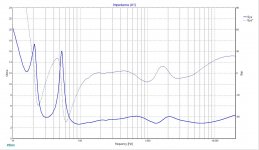 impedance.jpg135.8 KB · Views: 179
impedance.jpg135.8 KB · Views: 179 -
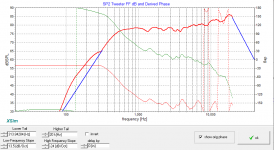 tweeter response tails.PNG12.8 KB · Views: 121
tweeter response tails.PNG12.8 KB · Views: 121 -
 woofer response tails.PNG13.6 KB · Views: 113
woofer response tails.PNG13.6 KB · Views: 113 -
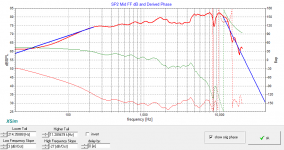 mid response tails.PNG12.1 KB · Views: 120
mid response tails.PNG12.1 KB · Views: 120 -
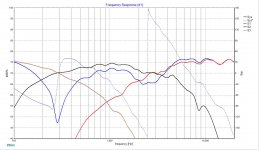 SPL_no_inverted_mid.jpg133.6 KB · Views: 195
SPL_no_inverted_mid.jpg133.6 KB · Views: 195 -
 IMG_2561.png1.6 MB · Views: 223
IMG_2561.png1.6 MB · Views: 223 -
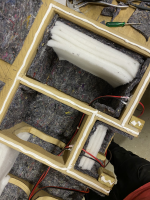 IMG_2557.png4.9 MB · Views: 192
IMG_2557.png4.9 MB · Views: 192 -
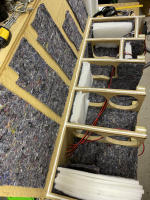 IMG_2556.png5.7 MB · Views: 150
IMG_2556.png5.7 MB · Views: 150
Last edited:
I have the SS 6620 and I think you can easily push the x-over between mid and tweet lower (e.g. 2000-2500) to help with distortion and off axis response. The 6600 series is designed for lower frequency extension instead of high frequency extension so it can play down to 1500hz without issues. I use LW 4th order xover so it might be different with what you have here but theres a test on heissmann that confirms its ability.
And your cabinet is already much overbuilt for its size.
Other than that, I highly recommend a minidsp to correct any room mode. You can make the curve ruller flat in the software but in room response might still be very bumpy.
And your cabinet is already much overbuilt for its size.
Other than that, I highly recommend a minidsp to correct any room mode. You can make the curve ruller flat in the software but in room response might still be very bumpy.
Yes, it seems if I push the XO point to 2000Hz, the power dissipation of the resistors is significantly reduced as well.I have the SS 6620 and I think you can easily push the x-over between mid and tweet lower (e.g. 2000-2500) to help with distortion and off axis response. The 6600 series is designed for lower frequency extension instead of high frequency extension so it can play down to 1500hz without issues. I use LW 4th order xover so it might be different with what you have here but theres a test on heissmann that confirms its ability.
And your cabinet is already much overbuilt for its size.
Other than that, I highly recommend a minidsp to correct any room mode. You can make the curve ruller flat in the software but in room response might still be very bumpy.
Another thing is that I can remove the parallel notch filter, because the slope of the filter can be used to tame the 1500Hz peak.
Attachments
Assuming you got the impedance right (simulated or measured), the x/o filter of woofer and midrange ought to be modified to present a milder load to amplifier. 60-150 Hz is burdened with too low of a Z and to high a phase angle. Tweeter x/o is not phase compensated. Use asymmetrical filters with flat and straight/vertical baffles.
Last edited:
Assuming you got the impedance right (simulated or measured), the x/o filter of woofer and midrange ought to be modified to present a milder load to amplifier. 60-150 Hz is burdened with too low of a Z and to high a phase angle. Tweeter x/o is not phase compensated. Use asymmetrical filters with flat and straight/vertical baffles.
Feeling a little lost here, so please excuse if the questions that follow are lame. 🙂
Using 4 Ohm drivers, I really cant see how I can achieve much higher impedance than this without wiring resistors in series with the drivers. Maybe there is something I'm missing here?
Is the problem with the steep phase angles in the sub 300 range? These are as measured on the naked driver in the enclosure and don't seem to be affected that much by the crossover. Or are you talking about the angles above 1000Hz?
How do you think I would best correct the phase?
Study B&W service manuals, they are freely available. Do not use very large capacitors in woofer filter and push the woofer/mid x/o point more to the right. Increase the filter order of the woofer LP circuit, as done by B&W. These measures will reflect themsleves as improvement of impedance. A truly successful passive loudspeaker has got both impedance and SPL optimized.
- Home
- Loudspeakers
- Multi-Way
- Seeking input on ScanSpeak 3-way

